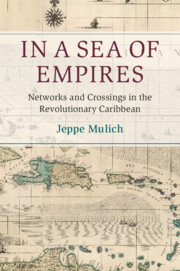Book contents
- In a Sea of Empires
- Cambridge Oceanic Histories
- In a Sea of Empires
- Copyright page
- Dedication
- Contents
- Figures
- Tables
- Acknowledgments
- 1 Introduction
- 2 Free Ports and Black Markets
- 3 Imperial Warfare, Colonial Violence
- 4 Prize Courts and Privateers
- 5 Slave Laws and Free Communities
- 6 Abolition and the Illegal Slave Trade
- Conclusion
- Bibliography
- Index
4 - Prize Courts and Privateers
Published online by Cambridge University Press: 24 June 2020
- In a Sea of Empires
- Cambridge Oceanic Histories
- In a Sea of Empires
- Copyright page
- Dedication
- Contents
- Figures
- Tables
- Acknowledgments
- 1 Introduction
- 2 Free Ports and Black Markets
- 3 Imperial Warfare, Colonial Violence
- 4 Prize Courts and Privateers
- 5 Slave Laws and Free Communities
- 6 Abolition and the Illegal Slave Trade
- Conclusion
- Bibliography
- Index
Summary
Chapter 4 examines the resurgent privateering of the early nineteenth century in order to analyze the way in which trans-imperial networks of the Leeward Islands were connected to wider regional and oceanic networks. Privateering as a political and strategic tool was a thoroughly Atlantic phenomenon, with actors on either side of the ocean employing privateers in order to weaken the maritime sinews of their rivals or to project claims of sovereignty to foreign powers. The Caribbean was at the center of the practice as the region provided fertile ground for recruiting crews, outfitting vessels, and raiding rival ships. The chapter also delves into the specifics of the colonial prize court system, particularly in the British Empire, in order to illuminate the legal framework for privateering and the crucial role played by vice admiralty courts in imperial clashes over jurisdiction and politico-legal power
- Type
- Chapter
- Information
- In a Sea of EmpiresNetworks and Crossings in the Revolutionary Caribbean, pp. 81 - 101Publisher: Cambridge University PressPrint publication year: 2020

